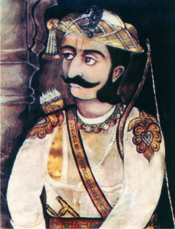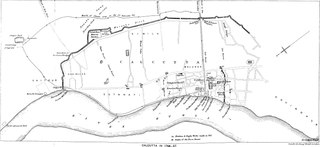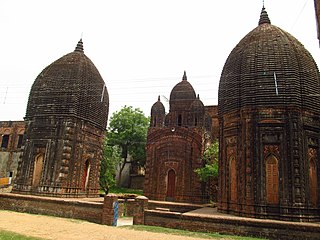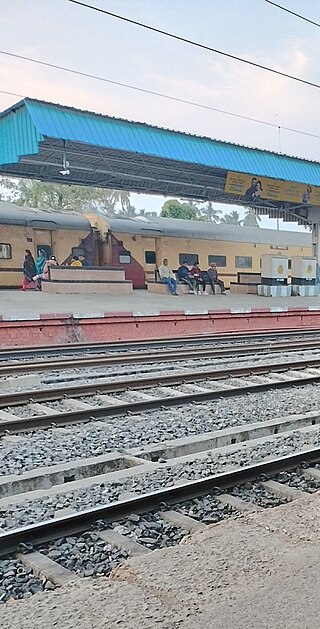
The Maratha Confederacy, also referred to as the Maratha Empire, was an early modern polity in the Indian subcontinent. It comprised the realms of the Peshwa and four major independent Maratha states often subordinate to the former. It was established in 1674 with the coronation of Shivaji as the Maratha Chhatrapati and recognised by Emperor Bahadur Shah I as a tributary state in 1707 following a prolonged rebellion. Following this, the Marathas continued to recognise the Mughal emperor as their nominal suzerain, similar to other contemporary Indian entities, though in practice, imperial politics at Delhi were largely influenced by the Marathas between 1737 and 1803.

The Battle of Plassey was a decisive victory of the British East India Company, under the leadership of Robert Clive, over the Nawab of Bengal and his French allies on 23 June 1757. The victory was made possible by the defection of Mir Jafar, Nawab Siraj-ud-Daulah's commander in chief as well as much of the Bengal Subah's armies being earlier committed against an Afghan invasion led by Ahmad Shah Durrani against the Mughal Empire. The battle helped the British East India Company take control of Bengal in 1772. Over the next hundred years, they continued to expand their control over vast territories in the rest of the Indian subcontinent, including Burma.

Balaji Baji Rao, often referred to as Nana Saheb I, was the 8th Peshwa of the Maratha Confederacy. He was appointed as Peshwa in 1740 upon the death of his father, the Peshwa Bajirao I.

Madhavrao I was the son of Peshwa Balaji Bajirao and grandson of Peshwa Bajirao I who served as 9th Peshwa of the Maratha Confederacy. During his tenure, the Maratha Confederacy recovered from the losses they suffered during the Third Battle of Panipat, an event known as Maratha Resurrection.

Shah Alam II, also known by his birth name Ali Gohar, or Ali Gauhar, was the seventeenth Mughal emperor and the son of Alamgir II. Shah Alam II became the emperor of a crumbling Mughal Empire. His power was so depleted during his reign that it led to a saying in the Persian language, Sultanat-e-Shah Alam, Az Dilli ta Palam, meaning, 'The empire of Shah Alam is from Delhi to Palam', Palam being a suburb of Delhi.

Katwa is a sub-divisional town and railway junction in Purba Bardhaman district of the Indian state of West Bengal. It is the headquarters of the Katwa subdivision. The town was built at the confluence of Ganga and Ajay. Katwa is a border city of three districts; Purba Bardhaman District, Nadia District and Murshidabad District.
Dainhat is a town and a Municipality under Katwa police station of Katwa subdivision, in Purba Bardhaman district in the state of West Bengal, India.

Alivardi Khan was the fourth Nawab of Bengal from 1740 to 1756. He toppled the Nasiri dynasty of Nawabs by defeating Sarfaraz Khan in 1740 and assumed power himself.

The Kingdom of Nagpur was a kingdom within the Maratha Confederacy in the 18th and 19th centuries. It was ruled by the Maratha Bhonsle dynasty in the mid-18th century. The city of Nagpur was the capital of the state.

Raghuji I was a Maratha general of the Bhonsle clan who established the Nagpur Kingdom in much of east-central India during the reign of Chhatrapati Shahu I. His successors ruled the kingdom until 1853.
Bargis were a light cavalry mercenary group of Maratha Empire's who indulged in large scale plundering of the countryside of western part of the Bengal Subah for about ten years (1741–1751) during the Maratha invasions of Bengal. Maratha invasions took place almost as an annual event for 10 years.

The Maratha invasions of Bengal (1742–1751), also known as the Maratha expeditions in Bengal, were the frequent invasions by the Maratha forces in the Bengal Subah, after their successful campaign in the Carnatic region at the Battle of Trichinopoly. The leader of the expeditions was Raghoji Bhonsle of Nagpur. The Marathas invaded Bengal many times from April 1742 to March 1751, which caused widespread economic losses in the Bengal Subah.

The Bengal Subah, also referred to as Mughal Bengal, was the largest subdivision of Mughal India encompassing much of the Bengal region, which includes modern-day Bangladesh, the Indian state of West Bengal, and some parts of the present-day Indian states of Bihar, Jharkhand and Odisha between the 16th and 18th centuries. The state was established following the dissolution of the Bengal Sultanate, a major trading nation in the world, when the region was absorbed into the Mughal Empire. Bengal was the wealthiest region in the Indian subcontinent.
The Battle of Burdwan occurred between the Bengal Subah and the Maratha Confederacy in 1747. After the dismissal of Mir Jafar by Alivardi Khan, an army was amassed to defend against the invading Maratha forces of Janoji Bhonsle at Orissa. Alivardi Khan managed to heavily repulse and defeat the Marathas in this battle.
The First Battle of Katwa occurred between the Bengal Subah and Maratha Confederacy in 1742. The Marathas under Raghoji initially attacked and captured Katwa and Hooghly in Bengal. The Nawab of Bengal Alivardi Khan, using conscripted tribal and peasant levies from Birbhum, responded with a direct attack on the Maratha camp at Katwa from the rear in nightfall and the entire Maratha Army was evacuated out of Bengal on 17 September 1742, believing a much larger force had charged them. The Maratha commander Bhaskar Pant was treacherously killed.

Sribati or Sreebati is a village and gram panchayat in Katwa II CD block in the Katwa subdivision of Purba Bardhaman district of West Bengal.

Bansberia railway station is railway station on Bandel–Katwa line, in Bengal, India connecting from Bandel to Katwa, and under the jurisdiction of Howrah railway division of Eastern Railway zone. It is situated at Bansberia, Hooghly district in the Indian state of West Bengal. It serves Bansberia town, Boropara, Chak Bansberia and surrounding area. The distance between Howrah and Bansberia railway station is approximately 44 km.
Bhaskar Ram Kolhatkar, known as Baba Bhaskar Pandit or Bhaskar Pant by the people of Bengal and Maharashtra, was a Maratha general and statesman. He was the dewan of the Maharaja of Nagpur, Raghuji Bhonsle. He played an important role in the kingdom of Nagpur's expansion. The first Maratha invasion of Bengal in 1741, as also the third in 1744, was led by him. He was an able military leader, proven by his success in the Maratha invasions of Bengal and conquest of Chhattisgarh. He was killed by Alivardi Khan on 30 March 1744.
In 1746, the Independent Nawabs of Bengal and the Maratha Confederacy fought each other at the Second Battle of 'Midnapore'.
The Battle of Birbhum occurred in 1743 and took place between the Bengali forces led by Alivardi Khan against the Maratha Confederacy which was led by Raghuji I.












